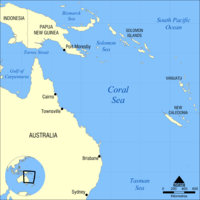
Photo from wikipedia
Abstract In the southern oceans, only a few cold-water coral mound sites have so far been reported compared to the extensively surveyed North Atlantic. Here, we document for the first… Click to show full abstract
Abstract In the southern oceans, only a few cold-water coral mound sites have so far been reported compared to the extensively surveyed North Atlantic. Here, we document for the first time the widespread occurrence of exposed and buried coral mounds at the northern Argentine margin named Northern Argentine Mound Province (NAMP). The integration of multibeam bathymetry, sediment echosounder, Acoustic Doppler Current Profiler (ADCP), and CTD data allowed the characterisation of its morphosedimentary, stratigraphic, and hydrodynamic setting. The NAMP, covering at least 2000 km2, represents the largest coral mound province in terms of areal extent reported so far and a major site in the southern oceans. The coral mound distribution is directly linked to morphosedimentary features of the regional Contourite Depositional System (CDS) influenced by the Antarctic Intermediate Water (AAIW), the Upper Circumpolar Deep Water (UCDW), and their interface, forming a complex bottom-current-controlled environment here termed Coral-Contourite System. Coral mounds are most abundant in the lower AAIW between 900 and 1050 m, just above the Ewing Terrace Moat, which has been shaped by high-velocity currents associated with the AAIW-UCDW boundary. This clustering appears to be the result of an increased concentration of suspended sediment and food particles, transported along the AAIW-UCDW density gradient and delivered upward by turbulent hydrodynamic processes, which are enhanced by the irregular moat topography. Within the Ewing Terrace Moat, coral mounds are restricted to topographic obstacles, modifying the otherwise highly erosive, destructive hydrodynamic regime and thereby locally creating favourable conditions for coral growth. The low-velocity currents of the UCDW, currently influencing the Ewing Terrace, promote extensive contourite deposition, which has led to a progressive demise and burial of pre-existing mounds. The presence of these buried mounds suggests past mound aggradation 100 to 150 m deeper likely due to a downward shift of the AAIW during glacials as a consequence of sea-level lowering. Overall, the mound formation in the NAMP seems to be mainly controlled by the availability of suspended particles, in combination with a sufficient bottom-current strength, keeping material in suspension while preventing destructive erosion and excessive sedimentation. Our study highlights (1) the importance of high-energy processes at water-mass boundaries for the delivery of sediment and food particles to corals, (2) the role of the AAIW as a crucial water mass for coral mound development, (3) the variability of mounds in response to glacial-interglacial cycles, and (4) the potential of CDSs in general and the Argentine margin in particular as hotspots for coral mounds and, thus, ideal site for future studies.
Journal Title: Marine Geology
Year Published: 2020
Link to full text (if available)
Share on Social Media: Sign Up to like & get
recommendations!